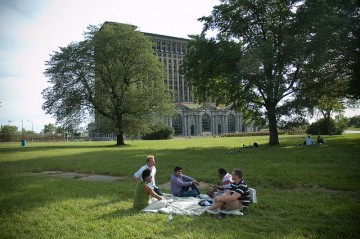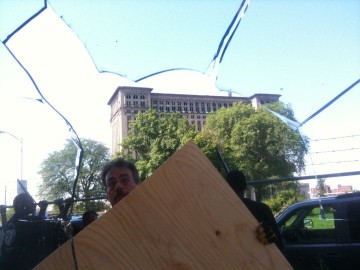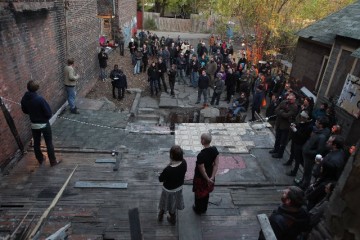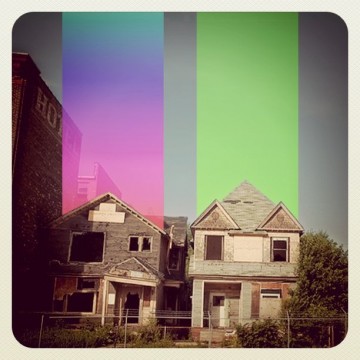
A group of Detroiters gathers on the lawn in front of Michigan Central Train Station, image courtesy of Imagination Station.
The abandoned buildings in Detroit have an air of nostalgia and a visceral seductiveness. When encountered for the first-time, they can be overwhelming. No building represents the affects of ruin shock better than the infamous Michigan Central Train Station. Images of the ruins of Detroit–especially Michigan Central Station–have come to [mis]represent the city in the mass media. Erected in 1914, the building was at one time the fourth largest building in Detroit. Built to sustain the growing population of people flocking to the city, Michigan Central is a trace of what Detroit used to be.
One of the first duos to gain recognition for this type of work is the collaborative duo of Yves Marchand and Romain Meffre, young French photographers who began documenting the abandoned buildings of Detroit in 2005. The fruit of their labor, Ruins of Detroit, is a large expensive book of photographs with an introduction by Thomas Sugrue, famed American historian, professor, and author of Origins of the Urban Crisis: Race and Inequality in Post-War Detroit. Photographic excerpts from Ruins of Detroit were digitally published in the aforementioned New York Times photo essay, as part of “Assignment Detroit.” Titled “Detroit’s Beautiful, Horrible Decline,” Marchand’s and Meffre’s images documented a sample of run-down and dilapidated buildings.
In Freud’s essay, “Notes on the Mystic Writing Pad,” the author elucidates a psychoanalytically-informed theory that memories are traces forever imprinted onto the individual’s psyche. Michigan Central Station, which closed its doors in 1988, is a relic of a history past, concrete evidence of a former time, forever imprinted in the minds of Detroiters. The building itself is a trace, proof that the city was a bustling metropolis. The sheer magnitude of the structure leaves a mark of its past on the present landscape, and entices eager viewers to visit and photograph it. Imprints of another time and moments forever frozen.
One could shift his or her gaze across the street and encounter a different representation of Detroit, a response to neighborhood disintegration: the site-specific, community-based Imagination Station.
Located kitty corner from Michigan Central, Imagination Station is a non-profit organization dedicated to fulfilling a need in the southwest Detroit community of Corktown. (The oldest neighborhood in the city, Corktown was settled by Irish immigrants in the mid-19th century.) Co-founded by Mary Lorene Carter, Jeff DeBruyn, and Jerry Paffendorf, Imagination Station has taken up residence at 2230 and 2236 14th Street in Detroit. The impetus for the project, as Carter explains, was the lack of technological access for citizens in this community. The founders responded by devising a plan for an arts and technology center at the location of the two dilapidated houses.
The process is twofold. The first portion of their project has featured an artist-in-residence program that invited painter Marianne Audrey Burrows and architect Catie Newell to respond to the blighted site at 2230 prior to demolition. Burrows and Newell activated the location with site-specific installation work that responded to the framework and history of the house.
A video of the project created by Detroit-based filmmaker Stephen McGee.
The second portion of the project is to implement a sustainable model for digital and technological access, while responding to a blighted site. “Jerry [Paffendorf] and I have long thought that one thing that puts Detroit at a severe disadvantage is its lack of digital literacy,” says Carter. “When we finish the rehab of 2230, the second floor will have a space for a technologist-in-residence, who will have the time and facilities to work on [his or her] own projects, continue work on technology initiatives for the Imagination Station.” Carter notes how invested the team is in making media available to residence of the Corktown neighborhood: “2230 14th will undergo a rehab that turns it into a media center that services the community. The technologist-in-residence, along with Imagination Station staff, will regularly host classes that will educate the community on various technology and media skills.”

Image of Young Detroit Builders taken from the inside of the dilapidated buildings prior to demolition. (c) 2009 Catie Newell.
The Imagination Station’s plans for community outreach and educational programming are to make the site accessible to Detroiters at multiple skill levels. Courses will be offered in basic word processing and emailing, computer programming and web development, digital photography and film-making, and Adobe Photoshop and Illustrator.

Crowd gathering at Imagination Station for the opening of Catie Newell's installation. Courtesy Catie Newell and Imagination Station.
Successful and creative funding strategies, regardless of location, are key in this economic climate. Fundraising is running concurrent with this space activation, and Imagination Station has been working with the Internet start-up company, LOVELAND. LOVELAND is also run by Carter and Paffendorf as a separate entity that works to create innovative approaches to crowd funding for this project and others.
Brandon Walley, the Director of Development for the Imagination Station, is the same person responsible for raising an astonishing $67,436 to build a Robocop Statue in the city. While I may not agree with the necessity of a Robocop statue in Detroit, Walley is showing investors that there are unique ways to give, and states that he intends to redirect future efforts towards more sustainable ventures.
Independent, site-specific art projects in Detroit continue to multiply and divide outside of the structural framework of more traditional museum and institutional spaces. Another group of Detroiters taking blight and sustainability as a motif for urban renewal is the Power House Project. Located in Hamtramck, the PHP was started by husband and wife duo, Mitch and Gina Cope. Inspired to create sustainable models of living with abandoned buildings as its canvas, PHP began with one site and has grown into multiple locations. The duo has also inspired their friends to purchase homes in the neighborhood, and teamed up with Juxtapoz Magazine last year to host a fundraiser for the site.
As noted on the website, Power House Project is “an incorporated nonprofit whose mission is to develop and implement neighborhood stabilization strategies in a Detroit neighborhood near Hamtramck. Our program focuses on integrating artists live/work spaces and using art and cultural resources to revitalize the neighborhood.” Its programming and outreach, much like the Imagination Station’s, is two-fold. The first portion is to create an international artist-in-residency program at the site, and the second is to build and maintain community via the site.
Power House Project began under the auspices of Design 99, a collective run by both Mitch and Gina that believes in making design affordable to all. From their website: “Design 99 seeks to break the notion of contemporary design as inexpensive and inaccessible. From tricking out multi-family immigrant homes to posh downtown lofts, we approach each project with the same contemporary mindset–albeit different budgets–making contemporary art, architecture and design available to a wider public through over-the-counter design services.” Design 99’s work extends beyond the sphere of the neighborhood, as it has been the artist-in-residence at the Detroit Institute of Arts and was asked to be in the Heartland exhibition that made a stop in Chicago at the Smart Museum almost two years ago.
Both the Power House Project and Imagination Station are site-specific, community based art projects that tackle the needs of a neighborhood and its community. Site-specificity is a central theme in Detroit. Public art projects that provide a site for visiting artists to live and work, introduce new technology, create models for sustainability, and create a space for community to congregate will hopefully help to create an alternative model to the utilization of urban space in the city.





